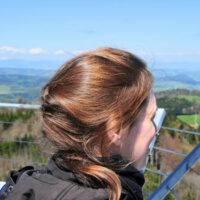Hi Daniel-
You have a good start in your planning with Annika’s advice.
Here are a few links that can help you, as well.
http://www.alpenwild.com/stat icpage/trail-signs-swiss-alps/
This excellent topo map can show you quite small details; I have turned on the overlay for “die Wanderwege” – the marked and maintained hiking trails. The color coding follows the conventions in the above link:
map.geo.admin.ch/?topic=swisstopo&lang=e n&bgLayer=ch.swisstopo .pixelkarte-farbe&layers=ch.swisst opo.zeitreihen,ch.bfs. gebaeude_wohnungs_regi ster,ch.swisstopo.swis stlm3d-wanderwege,ch.swisstop o.landeskarte-farbe-10&layers_visibility=f alse,false,true,false& layers_timestamp=18641 231,,,&X=161280.00&Y=6 37460.00&zoom=5
The maps in Switzerland Mobility (linked by Annika) are also quite detailed.
Annika’s link on preparation emphasizes altitude as a determinant of hiking ease ( and speed). Even at 1600-1700 meters (about a mile high, if you prefer English units), some people find it takes a few days to be comfortable with strenuous exercise, until their bodies become acclimated to the “thin” air and reduced oxygen availability. If you are hiking at 2000 meters and above, even if you are fit, you may find that you have to slow down or pause for breath, meaning it will take a a lot longer than you might expect to cover a stretch of trail with a lot of ups and downs or a climb of hundreds of meters. (Hence, Annika’s comment about checking altitude profiles.) One of the reasons that I like the Switzerland mobility web site is the altitude profiles.
If you find you want to do shorter hikes, or return to base each night, this link can offer some suggestions:
http://www.jungfrau.ch/en/som mer/tourism/destinatio ns/kleine-scheidegg/hiking-trails/
The preparations linked to by Annika are quite important. The weather can change very quickly in the Alps. Although it is certainly far from likely, snow is possible even in August, and thunderstorms arr rather common in the Alps in August. Make sure you have warm clothing and wet weather gear with you in case the weather changes suddenly.
On any but the most easy trails ( the yellow ones on the Swiss topo map) good gear makes the trip easier, faster, and, most critically, safer. Note the advice for good boots – study shoes with lugged soles are a reasonable alternative, but boots give ankle support. The extra stability from using hiking staff(s) becomes apparent on the rough trail sections – especially when you are going downhill. Or, when hiking on scree.
You should be aware of the available mountain rescue services (especially useful in ski season.) Two of our good friends, experienced hikers, slipped on easy trails on different ocasions and broke their ankles, and had to use the helicopter services one called REGA.
I maintain a membership in the most common (and original) one – REGA – which costs us around 60 USD per year for a family, or around 30USD per person. Cheap insurance. I know you are on a budget, but I thought I would mention this . They take credit cards, but you have to dig into the site a bit to figure it out. If you are in Europe, they have a ‘konto” number for funds transfer.
If you don’t have the membership (which is insurance, actually) they’ll get you anyway, but you’ll get a bill for a few thousand CHF or USD. The Swiss like you to pay your debts.
http://www.rega.ch/en/home.as px
(They call their members “patrons” – in German, “die Gönner.”)
Check out all this information on the Via Alpina:
http://www.wanderland.ch/en/r outes/national-routes/route-01.html
I can’t name the small lake in the picture you attached in your message. Perhaps someone else can.
Annika has already mentioned sections 1.10 and 1.11.
There are no SAC huts on those sections. Follow the links under Services to find accomodations.
Also,notice the warning :
<<“Beware: snowfields possible into summer months on high-level sections.”>>
Slowpoke
